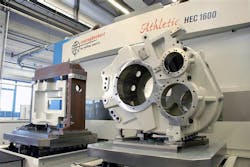The European Machine Tool Industry Association (CECIMO) concluded its annual general assembly this week with an encouraging outlook for its members’ industrial output and an even more optimistic view of the trend for machine tool exports. These were offered in spite of the evidence of global industrial weakness, the group acknowledged.
Brussels-based CECIMO is a union of trade associations for over 1,500 companies across the European Union, companies who are responsible for 97% of machine tool production in the region. They also comprise over 33% of the world’s machine tool production capacity. In addition to documenting trade and production developments, the group works to articulate policies for the machine tool sector.
Machine tool production in the EU rose 5% from 2014 to 2015, to €24.3 billion total, and CECIMO estimates now that this volume will remain even for 2016. This is based on the assumption that economic activity in Europe is stable, with indicators of strong consumer spending, a “very accommodative monetary policy,” and rising levels of business confidence, all of which point to an increase in capital investment in Europe.
EU machine tool exports came close to matching the all-time (2012) record during 2015, at €18.9 billion, and CECIMO projects now that figure will rise to €19.0 billion for 2016. This view is based on the strength of demand in developed economies, and China’s so-far successful effort to transition from export-based economics to growth based on domestic demand.
Another factor in CECIMO’s positive forecast is a more stable industrial economy in the Euro region, which is expected to drive growth in machine tool imports to the region. Last year the region posted machine-tool imports totalling €9.8 billion, and CECIMO expects the current year to show 3% growth in that total, or roughly €10.1 billion for 2016.
European machine-tool consumption increased 12% from 2014 to 2015, to €14.9 billion last year, but that growth is expected to slow to 1% for 2016, with the machines’ value estimated at €15.4 billion. This outlook is supported by data on new machine-tool orders in the EU, and CECIMO forecast European machine tool consumption to grow about 3.7% annually for the next three years.
“We are glad to see that the machine tool consumption in Europe shows good pace,” commented Dr. Frank Brinken, chairman of the CECIMO Economic Committee and vice-chairman of Starrag Holding AG. “Upgrading and modernizing its production base is an essential condition to keep the competitiveness of European manufacturing sector at high levels.”
The closing of the annual meeting also provided a chance for CECIMO to enunciate its policy priorities: It stipulated that European policy leaders must “move faster and generate the framework conditions” that will stimulate wider use of digital technologies, to promote increases in productivity, energy efficiency, and mass customization, altogether generating great avenues for the re-industrialization of Europe”.
Specifically, CECIMO called for “instruments” that will promote collaboration between the advanced manufacturing and IT sectors, in particular small and mid-sized businesses working in digital manufacturing.
Luigi Galdabini, president of CECIM, said: “We need large-scale initiatives launched by public authorities putting together various actors of digital manufacturing at (the) transnational level. Digitization is a key issue for machine tool builders and our companies are the heart of the value chain. For Europe to realize its re-industrialization, policy-makers must develop a holistic approach addressing the entire manufacturing value chain.”
The group also articulated a growing concern among European machine tool builders that manufacturing plants in the region are growing obsolete. “Despite the existence of a political will to advance manufacturing in Europe, progress on investing in new machines and equipment by industrial users has been insignificant so far,” according to their statement. “Further delays in the recovery of investments in machinery and equipment weaken the entire competitiveness of the European manufacturing industry.”
“The slowdown in demand for new equipment hampers the ability of developing breakthrough production technologies, as innovation is mainly driven by customer demands and cooperation between suppliers and users in the machine tool sector,” according to Filip Geerts, CECIMO director
“We urgently need an action plan mobilizing the EU’s major policy instruments to put an end to the lack of investment in modern production equipment by end-users,” Geerts continued.
About the Author
Robert Brooks
Content Director
Robert Brooks has been a business-to-business reporter, writer, editor, and columnist for more than 20 years, specializing in the primary metal and basic manufacturing industries.
